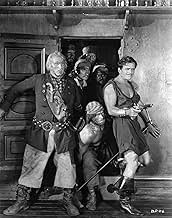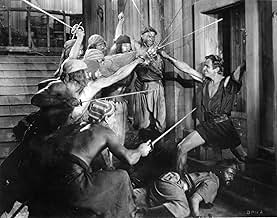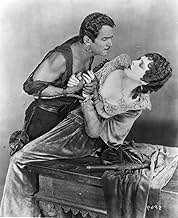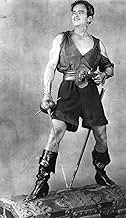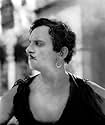IMDb RATING
7.0/10
2.3K
YOUR RATING
Seeking revenge, an athletic young man joins the pirate band responsible for his father's death.Seeking revenge, an athletic young man joins the pirate band responsible for his father's death.Seeking revenge, an athletic young man joins the pirate band responsible for his father's death.
- Director
- Writers
- Stars
- Awards
- 3 wins total
Douglas Fairbanks
- The Duke of Arnoldo
- (as Mr. Douglas Fairbanks)
- …
Billie Dove
- Princess Isobel
- (as Miss Billie Dove)
Tempe Pigott
- Duenna
- (as Miss Tempé Pigett)
Donald Crisp
- MacTavish
- (as Mr. Donald Crisp)
Sam De Grasse
- Pirate Lieutenant
- (as Mr. Sam de Grasse)
Anders Randolf
- Pirate Captain
- (as Mr. Anders Randolf)
Charles Stevens
- Powder Man
- (as Mr.Charles Stevens)
John Wallace
- Peg-Leg Pirate
- (as Mr. John Wallace)
Fred Becker
- Pirate
- (as Mr. Fred Becker)
Charles Belcher
- Chief Passenger - Nobleman
- (as Mr. Charles Belcher)
E.J. Ratcliffe
- The Governor
- (as Mr. E. J. Ratcliffe)
Jimmy Dime
- Pirate
- (uncredited)
George Holt
- Pirate
- (uncredited)
Dave Kashner
- Pirate
- (uncredited)
Stubby Kruger
- Pirate
- (uncredited)
Charles Lewis
- Pirate
- (uncredited)
Barry Norton
- Youth
- (uncredited)
- Director
- Writers
- All cast & crew
- Production, box office & more at IMDbPro
Featured reviews
This was an excellent pirate movie and was better than many sound pirate films. However, it's really hard to rate the movie---compared to other silent pirate films, it might just be the best. But, compared to THE SEA HAWK, CAPTAIN BLOOD or THE BLACK SWAN (all wonderful sound pirate films from the 30s and 40s), it isn't as good a film.
So what does the movie do that worked so well for me? First, being a Douglas Fairbanks film, it had wonderful stunts and impeccable production values--something he was known for in his silent films. Second, this film had excellent sets and was the best film money could buy in its day. In fact, it was such a lavish production that it was supposedly the first full-length film made in 2-color Technicolor--an early and somewhat crude way of producing a color movie. Because the film was dyed with green-blue and orange-red dyes, the film mostly looks reddish-green--definitely NOT true color. But, it doesn't look that bad--certainly much better than the horrid colorized films destroyed in the 1980s. Plus, if it hadn't been for films like this, the infinitely better 3-color system might never have been developed by Technicolor. And, finally, the plot is pretty good for a silent film--not the most complex when compared to later films, it's not nearly as simplistic as most other silents.
This video was produced by KINO FILMS. Some of their silent films in the past were less than wonderful (especially some of their Buster Keaton videotapes), but this videotape is top quality and has nice extras at the end of the tape. Some cheaper prints apparently are only black and white, not color. Nice job for the restoration, KINO! However, despite what the video box said, it was apparently NOT the first full-length two-color Technicolor film. I recently saw a restored print from TOLL OF THE SEA (1922) and it was in fact made using this process four years earlier than THE BLACK PIRATE.
So what does the movie do that worked so well for me? First, being a Douglas Fairbanks film, it had wonderful stunts and impeccable production values--something he was known for in his silent films. Second, this film had excellent sets and was the best film money could buy in its day. In fact, it was such a lavish production that it was supposedly the first full-length film made in 2-color Technicolor--an early and somewhat crude way of producing a color movie. Because the film was dyed with green-blue and orange-red dyes, the film mostly looks reddish-green--definitely NOT true color. But, it doesn't look that bad--certainly much better than the horrid colorized films destroyed in the 1980s. Plus, if it hadn't been for films like this, the infinitely better 3-color system might never have been developed by Technicolor. And, finally, the plot is pretty good for a silent film--not the most complex when compared to later films, it's not nearly as simplistic as most other silents.
This video was produced by KINO FILMS. Some of their silent films in the past were less than wonderful (especially some of their Buster Keaton videotapes), but this videotape is top quality and has nice extras at the end of the tape. Some cheaper prints apparently are only black and white, not color. Nice job for the restoration, KINO! However, despite what the video box said, it was apparently NOT the first full-length two-color Technicolor film. I recently saw a restored print from TOLL OF THE SEA (1922) and it was in fact made using this process four years earlier than THE BLACK PIRATE.
Douglas Fairbanks Snr., can quite fairly be given credit for the first movie action star. 'The Black Pirate' has a number of sequences which highlight his magnificent athletic ability. I found myself marveling at the extended sequence where he seizes a merchant ship singlehandedly. What strength and skill, what agility and courage! I loved watching him scale the stern of the ship and was extremely impressed by his cutting open of the sails from top to bottom with a knife. Some of the work was quite funny and you could tell that the filmed footage was being shown in reverse but that doesn't stop the stunts themselves from being extremely entertaining. He's got more guts than me, I'll say that much!
'The Black Pirate' is difficult to evaluate. Do we grade a film based upon:
a) other pirate films b) silent films c) on a general level of enjoyment against all films
As a silent film, and for that matter a two strip Technicolor silent film, 'The Black Pirate' is a landmark for innovation. Fairbanks had misgivings about the use of colour but felt a pirate film MUST be shown in colour. He gets great benefit. There is a great deal of implied violence (duh, a pirate film!) and the bright red colour of blood is almost shocking to see. There's a scene where a captive tries to hide a ring he's wearing by swallowing it. Unfortunately for him he's seen. After a little off camera ... searching... for the ring, a pirate presents a bloodied ring in bloodied hands as he wipes a bloodied dagger on his tunic to the captain. Pretty thrilling stuff for the 1920's. This was also a film where very serious philosophy and training were put to great effect with the fencing. You can see how it out-steps a lot of earlier swordplay films and influenced the style in films that would follow. According to film historian Rudy Behlmer on an excellent commentary track with the Kino DVD, the fencing master hired by Fairbanks became a staple of the industry. Many of the great sword fight movies from the next 25 years were his handiwork -- including 'The Adventures of Robin Hood,' and 'Captain Blood.'
Against other pirate films, 'The Black Pirate' has perhaps more value as a curiosity. Even by the late 1930's and 40's it was being outdistanced by Errol Flynn films like 'Captain Blood' and 'The Seahawk,' Tyrone Power in 'The Black Swan,' or Burt Lancaster in 'The Crimson Pirate.' Today it gets totally wiped off the board by the 'Pirates of the Caribbean' series. Though still fun to watch, these later films are better and more enjoyable.
This is definitely worth tracking down on the Kino DVD if you can find it. Rudy Behlmer has an excellent commentary track that is of great value to people who are interested in early Hollywood and Douglas Fairbanks. I recommend it highly for the student or the general enthusiast based upon that reason. And it is a good movie to! 'The Black Pirate' has a great sense of adventure to it with thrilling stunt work. Silent movie fans shouldn't be disappointed. Fans of pirate movies should give it a try to see what helped popularize the genre.
'The Black Pirate' is difficult to evaluate. Do we grade a film based upon:
a) other pirate films b) silent films c) on a general level of enjoyment against all films
As a silent film, and for that matter a two strip Technicolor silent film, 'The Black Pirate' is a landmark for innovation. Fairbanks had misgivings about the use of colour but felt a pirate film MUST be shown in colour. He gets great benefit. There is a great deal of implied violence (duh, a pirate film!) and the bright red colour of blood is almost shocking to see. There's a scene where a captive tries to hide a ring he's wearing by swallowing it. Unfortunately for him he's seen. After a little off camera ... searching... for the ring, a pirate presents a bloodied ring in bloodied hands as he wipes a bloodied dagger on his tunic to the captain. Pretty thrilling stuff for the 1920's. This was also a film where very serious philosophy and training were put to great effect with the fencing. You can see how it out-steps a lot of earlier swordplay films and influenced the style in films that would follow. According to film historian Rudy Behlmer on an excellent commentary track with the Kino DVD, the fencing master hired by Fairbanks became a staple of the industry. Many of the great sword fight movies from the next 25 years were his handiwork -- including 'The Adventures of Robin Hood,' and 'Captain Blood.'
Against other pirate films, 'The Black Pirate' has perhaps more value as a curiosity. Even by the late 1930's and 40's it was being outdistanced by Errol Flynn films like 'Captain Blood' and 'The Seahawk,' Tyrone Power in 'The Black Swan,' or Burt Lancaster in 'The Crimson Pirate.' Today it gets totally wiped off the board by the 'Pirates of the Caribbean' series. Though still fun to watch, these later films are better and more enjoyable.
This is definitely worth tracking down on the Kino DVD if you can find it. Rudy Behlmer has an excellent commentary track that is of great value to people who are interested in early Hollywood and Douglas Fairbanks. I recommend it highly for the student or the general enthusiast based upon that reason. And it is a good movie to! 'The Black Pirate' has a great sense of adventure to it with thrilling stunt work. Silent movie fans shouldn't be disappointed. Fans of pirate movies should give it a try to see what helped popularize the genre.
A nobleman vows vengeance on the cutthroats responsible for his father's death. Becoming THE BLACK PIRATE, he joins their scurvy crew and quickly becomes their leader. But his plans for revenge become more complicated when he meets his first captive - a beautiful Spanish princess.
Roistering, robust & richly detailed, this was one of Douglas Fairbanks' greatest films. With enough excitement to satisfy any lover of adventure, one needs only read the film's prologue to get an idea of its delights: 'A page from the History and Lives of the most Bloodthirsty PIRATES who ever infested THE SOUTHERN SEAS. Being an account of BUCCANEERS & the Spanish MAIN, the Jolly Roger, Golden Galleons, bleached skulls, BURIED TREASURE, the Plank, dirks & cutlasses, SCUTTLED SHIPS, marooning, DESPERATE DEEDS, DESPERATE MEN, and - even on this dark soil - ROMANCE.' Aside from the bleached skulls, everything else is there as promised
Fairbanks is a joy to behold, exulting in his physical prowess, becoming a legend of the screen before the delighted eyes of the viewer. Can any other swashbuckler top the flair or élan of the sequence where Doug captures a merchantman single-handed, climbing up the forecastle & sliding down the slit sails on his dagger, light as any sprite? No one else would have even dared.
As the princess, Billie Dove is beautiful, but has very little to do except look frightened. Donald Crisp, in a change of pace role, is very enjoyable as a gruff one-armed Scots pirate who befriends Fairbanks. Anders Randolf & Sam De Grasse are the black-hearted pirate captain & lieutenant whom Doug must contend with and they are nasty indeed.
A milestone in cinematic history, this was one of the first movies to be filmed entirely in Technicolor. In its restored version, it is very pleasant to the eyes, its antique hues perfectly complementing the richly textured art design, costumes & sets.
For those interested in such things, there are explanations for the various special effects (the underwater attack, for instance), but the reader will need to look elsewhere for them. Sometimes too many facts can spoil the illusion of daydreams so necessary for the enjoyment of silent cinema. Find this fabulous film & dream on.
Too bad about the bleached skulls, though...
Roistering, robust & richly detailed, this was one of Douglas Fairbanks' greatest films. With enough excitement to satisfy any lover of adventure, one needs only read the film's prologue to get an idea of its delights: 'A page from the History and Lives of the most Bloodthirsty PIRATES who ever infested THE SOUTHERN SEAS. Being an account of BUCCANEERS & the Spanish MAIN, the Jolly Roger, Golden Galleons, bleached skulls, BURIED TREASURE, the Plank, dirks & cutlasses, SCUTTLED SHIPS, marooning, DESPERATE DEEDS, DESPERATE MEN, and - even on this dark soil - ROMANCE.' Aside from the bleached skulls, everything else is there as promised
Fairbanks is a joy to behold, exulting in his physical prowess, becoming a legend of the screen before the delighted eyes of the viewer. Can any other swashbuckler top the flair or élan of the sequence where Doug captures a merchantman single-handed, climbing up the forecastle & sliding down the slit sails on his dagger, light as any sprite? No one else would have even dared.
As the princess, Billie Dove is beautiful, but has very little to do except look frightened. Donald Crisp, in a change of pace role, is very enjoyable as a gruff one-armed Scots pirate who befriends Fairbanks. Anders Randolf & Sam De Grasse are the black-hearted pirate captain & lieutenant whom Doug must contend with and they are nasty indeed.
A milestone in cinematic history, this was one of the first movies to be filmed entirely in Technicolor. In its restored version, it is very pleasant to the eyes, its antique hues perfectly complementing the richly textured art design, costumes & sets.
For those interested in such things, there are explanations for the various special effects (the underwater attack, for instance), but the reader will need to look elsewhere for them. Sometimes too many facts can spoil the illusion of daydreams so necessary for the enjoyment of silent cinema. Find this fabulous film & dream on.
Too bad about the bleached skulls, though...
Fun silent pirate movie , plenty of action , thrills , exciting sword-play , luxurious costumes , athletic feats , fabulous scenarios ; all meld together under Albert Parker's right direction . This exciting swashbuckling deals with the love story of a bold Buccaneer (Douglas Fairbanks) and a gorgeous princess (Billie Dove) and a subsequent vengeance . As a shipwrecked mariner vows vendetta on the pirates who destroyed his father's ship .As he writes on his father's tomb : ¨My father I solemnly vow¨. Seeking revenge, the athletic young man joins the pirate band led by a nasty captain (Randolf) responsible for his father's death . As Fairbanks uses all kind of shrewdness in order to penetrate a well-defended ship and take the command .
Amusing pirate movie , plenty of emotion , astounding adventures , realistic miniature work , evocative cinematography in black and white and luxurious costumes ; this is the quintaessential pirate movie . This classic story of romantic adventure come to life enriched by fabulous scenarios and adapted rightly to the screen . Overwhelming battle ships , sword-play and full of villainy , romance , swashbuckler and heroism . The picture is fast-moving , exciting and thrilling right up to the climatic confrontation between Douglas Fairbanks and his villain enemies . Big budgeted film by United Artists Pictures , using appropriate ship shots and miniature sets when possible . ¨Black pirate¨ results to be Douglas Fairbanks's swashbuckling best and has achieved a classic status . Charming Douglas Fairbanks steals the show when he bounds and leaps , flies and run ; in addition he is the screenwriter of this rollicking adventure . Fairbanks executes athletic feats , moving sword-play and spectacular acrobatics similarly he demonstrated in other classics such as The Mark of Zorro (1920), Robin Hood (1922), Three musketeers , Don Q Son of Zorro , The gaucho , The iron mask , The Taming of the Shrew , Don Juan , Mr Robinson , among others . Douglas performed most of the stunts in his films himself. He was an excellent athlete and used his physical abilities to his best advantage. Douglas was king of Hollywood by that time and he formed his own production company ; during a Liberty Bond tour with Charles Chaplin he fell in love with Mary Pickford with whom he, Chaplin and Griffith had formed United Artists in 1919. In fact, there is a cameo appearance by Mary Pickford as Princess Isobel in Final Embrace . Furthermore , there appears Nino Cochise, grandson of the famous Apache chief Cochise as an extra in this movie , it was his second extra job in Hollywood, his first one being in Douglas Fairbanks' Robin Hood . The crew of Douglas Fairbanks' longboat in the climactic chase and battle were members of the crew of the USS Arizona .
Bright black and white cinematography , though also available in color .This silent version was accompanied with an appropriate piano musical score . The motion picture was professionally realized by Albert Parker who directed some vehicles for Douglas Fairbanks . However , Donald Crisp -who plays a secondary role- was the original director, but after a few days of filming had a falling-out with star Douglas Fairbanks and was replaced by Parker.
Amusing pirate movie , plenty of emotion , astounding adventures , realistic miniature work , evocative cinematography in black and white and luxurious costumes ; this is the quintaessential pirate movie . This classic story of romantic adventure come to life enriched by fabulous scenarios and adapted rightly to the screen . Overwhelming battle ships , sword-play and full of villainy , romance , swashbuckler and heroism . The picture is fast-moving , exciting and thrilling right up to the climatic confrontation between Douglas Fairbanks and his villain enemies . Big budgeted film by United Artists Pictures , using appropriate ship shots and miniature sets when possible . ¨Black pirate¨ results to be Douglas Fairbanks's swashbuckling best and has achieved a classic status . Charming Douglas Fairbanks steals the show when he bounds and leaps , flies and run ; in addition he is the screenwriter of this rollicking adventure . Fairbanks executes athletic feats , moving sword-play and spectacular acrobatics similarly he demonstrated in other classics such as The Mark of Zorro (1920), Robin Hood (1922), Three musketeers , Don Q Son of Zorro , The gaucho , The iron mask , The Taming of the Shrew , Don Juan , Mr Robinson , among others . Douglas performed most of the stunts in his films himself. He was an excellent athlete and used his physical abilities to his best advantage. Douglas was king of Hollywood by that time and he formed his own production company ; during a Liberty Bond tour with Charles Chaplin he fell in love with Mary Pickford with whom he, Chaplin and Griffith had formed United Artists in 1919. In fact, there is a cameo appearance by Mary Pickford as Princess Isobel in Final Embrace . Furthermore , there appears Nino Cochise, grandson of the famous Apache chief Cochise as an extra in this movie , it was his second extra job in Hollywood, his first one being in Douglas Fairbanks' Robin Hood . The crew of Douglas Fairbanks' longboat in the climactic chase and battle were members of the crew of the USS Arizona .
Bright black and white cinematography , though also available in color .This silent version was accompanied with an appropriate piano musical score . The motion picture was professionally realized by Albert Parker who directed some vehicles for Douglas Fairbanks . However , Donald Crisp -who plays a secondary role- was the original director, but after a few days of filming had a falling-out with star Douglas Fairbanks and was replaced by Parker.
I knew little of this film before watching it, but am glad I found it. It's an excellent early film about a group of cutthroats. The thing that surprised me the most was that it was in color. It was filmed using the experimental two-color technicolor process. After watching the "Making of", apparently Douglas fairbanks was a real pioneer in that area and did much research on color film. This was my first Fairbanks film and I was quite impressed with not only his screen presence, but his ability to do impressive stuntwork, including the infamous sliding down a sail on a knife. This film had all the requirements of a pirate movie... Swordplay, torture, murder, robbery, kidnapping, romance, and even walking the plank. As well as the infamous quote, "Dead men tell no tales!". It had a decent score by Mortimer Wilson that was mostly fitting. One scene I found amusing, was when the pirates drew lots for the monkey. If you're a fan of pirate movies, this is a must see. I found it quite enjoyable.
*** (out of 4)
*** (out of 4)
Did you know
- TriviaThe double-thick Technicolor prints (two strips of dyed film, cemented together) presented numerous screening problems for untrained projectionists. If screened improperly, they would warp, scratch, etc. and due to the expense of printing in Technicolor at this time (since there were no optical printers, or any easier way of printing such technology in those days) forced the Fairbanks studio to issue a black-and-white version as well.
- GoofsAt about 31 minutes into the film, there are several shots of the "Black Pirate" aiming two swivel cannons at the viewer, interspersed with reaction shots of other actors. The first shot shows him in front of a whitish background (eg an overcast sky), the second such shot (a few seconds later) has a pitch black background. All such shots after that have the white background.
- ConnectionsEdited into Catalogue of Ships (2008)
- How long is The Black Pirate?Powered by Alexa
Details
Box office
- Budget
- $1,300,000 (estimated)
- Runtime1 hour 28 minutes
- Sound mix
- Aspect ratio
- 1.33 : 1
Contribute to this page
Suggest an edit or add missing content


